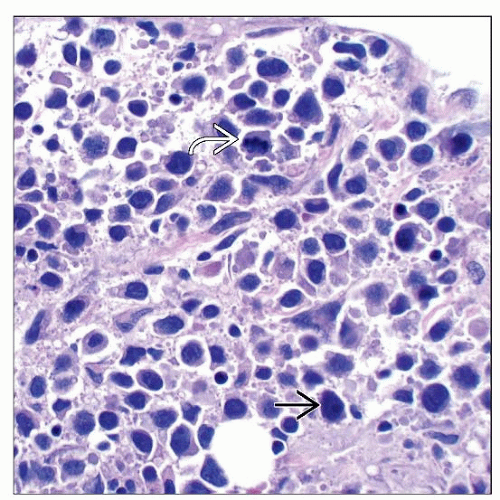Systemic T-cell and NK-cell Lymphomas Involving the Skin
Aaron Auerbach, MD, PhD
Key Facts
Terminology
Systemic T-cell or NK-cell lymphoma that has spread to the skin
Morphology of primary and secondary skin lymphomas are similar
Etiology/Pathogenesis
Epstein-Barr virus infection in some lymphomas
Clinical Issues
Often multiple lesions, less often single lesion
Most commonly in adults
Usually much worse prognosis than primary cutaneous lymphoma
Frequently aggressive chemotherapy, contrary to many primary cutaneous T-cell lymphomas, which are treated with more conservative therapy
Microscopic Pathology
Peripheral T-cell lymphoma, unspecified, includes any T-cell lymphomas that do not fit into a better defined subtype of T-cell lymphoma
Systemic ALK(+) anaplastic large cell lymphoma (ALCL): Often large atypical tumor cells in dermis, sometimes hallmark cells with multiple (horseshoeshaped nuclei)
Angioimmunoblastic T-cell lymphoma presents as superficial perivascular T-cell infiltrates with increased reactive inflammatory cells and high endothelial venules
Extranodal NK/T-cell lymphoma, nasal type, presents as medium to large cells with necrosis and angiocentricity that express T-cell and NK markers and are EBER(+)
 This is an example of a systemic anaplastic large cell lymphoma (ALCL) secondarily involving the skin. The lymphoid infiltrate diffusely fills the superficial and deep dermis. |
TERMINOLOGY
Abbreviations
Systemic T-cell lymphoma (STCL) involving skin
Synonyms
Secondary cutaneous T-cell lymphoma
Definitions
T-cell or NK-cell lymphoma that has spread to the skin as a secondary site of disease
Lymphoma originates systemically, but involves skin
Morphology of primary and secondary skin lymphomas are similar
Clinical behavior and treatment of each is divergent, however
ETIOLOGY/PATHOGENESIS
Depends on Type of NK/T-cell Lymphoma
Can be therapy related
Epstein-Barr virus infection in some lymphomas
Including angioimmunoblastic T-cell lymphoma and extranodal NK/T-cell lymphoma, nasal type
CLINICAL ISSUES
Epidemiology
Incidence
Secondary cutaneous lymphomas make up 50% of all cutaneous lymphomas, excluding mycosis fungoides
Secondary T-cell lymphoma in skin is less common than systemic B-cell lymphoma in skin
20-30% of peripheral T-cell lymphoma, unspecified, has cutaneous involvement
Represents ˜ 14% of all secondary skin lymphomas
˜ 50% of angioimmunoblastic T-cell lymphoma (AILT) have cutaneous lesions
˜ 8-20% of extranodal NK/T-cell lymphoma, nasal type involve skin
Age
Any age, but mostly adults
Systemic anaplastic large cell lymphoma (ALCL) displays a bimodal distribution that includes children, whereas primary cutaneous ALCL is primarily found in adults
Gender
Occurs in both males and females
Presentation
Often multiple lesions, less often single lesions
Usually tumors or nodules
Any cutaneous site, no site of predilection
Skin involvement may present at time of initial diagnosis or develop later
Treatment
Usually adjuvant therapy
Frequently aggressive chemotherapy, contrary to many primary cutaneous T-cell lymphomas, which are treated with more conservative therapy
Prognosis
Depends on type of T cell, but usually poor prognosis
Higher stage than primary cutaneous lymphoma
Usually much worse prognosis than primary cutaneous lymphoma
ALK(−) ALCL has a worse prognosis than primary cutaneous ALCL or systemic ALK(+) ALCL
MICROSCOPIC PATHOLOGY
Histologic Features
Morphology and immunophenotype sometimes identical to systemic disease
Peripheral T-cell lymphoma, not otherwise specified (PTCL, NOS)
All T-cell lymphomas that do not fit into a better defined subtype of T-cell lymphoma
Other types of T-cell lymphoma must 1st be excluded
Wide variety of morphologic appearances
Usually an atypical nodular or diffuse dermal T-cell infiltrate sparing epidermis, which may extend to subcutis
Medium to large T cells, often with markedly pleomorphic nuclei
Sometimes immunoblastic T cells or Reed-Sternberg-like T cells
Background reactive infiltrate including small lymphocytes, plasma cells, and eosinophils
Can be confused with infection, granuloma annulare, lupus or dermatomyositis, panniculitis and vasculitis
Systemic ALK(+) anaplastic large cell lymphoma (ALCL)
30% involve skin
Often large atypical tumor cells in dermis, sometimes hallmark cells with multiple (horseshoeshaped) nuclei
Usually no epidermotropism
Can involve lymphatic spaces
Systemic ALK(−) anaplastic large cell lymphoma
Same histology as systemic ALK(+) ALCL but considered a different disease than primary cutaneous ALCL
Angioimmunoblastic T-cell lymphoma (AITL)
Superficial perivascular infiltrates with lymphocytes, eosinophils, often plasma cells and histiocytes
Less often, may show more sheet-like, destructive dermal T-cell infiltrates
Increased numbers of high endothelial venules
Extranodal NK/T-cell lymphoma, nasal type
Dense dermal infiltrate
˜ 30% of cases show rare foci of epidermotropism
Perivascular/periadnexal
Medium/large irregular cells, sometimes with blastic chromatin
Coagulative necrosis in most cases
Tumor cells are angiocentric and angiodestructive
Stay updated, free articles. Join our Telegram channel

Full access? Get Clinical Tree





